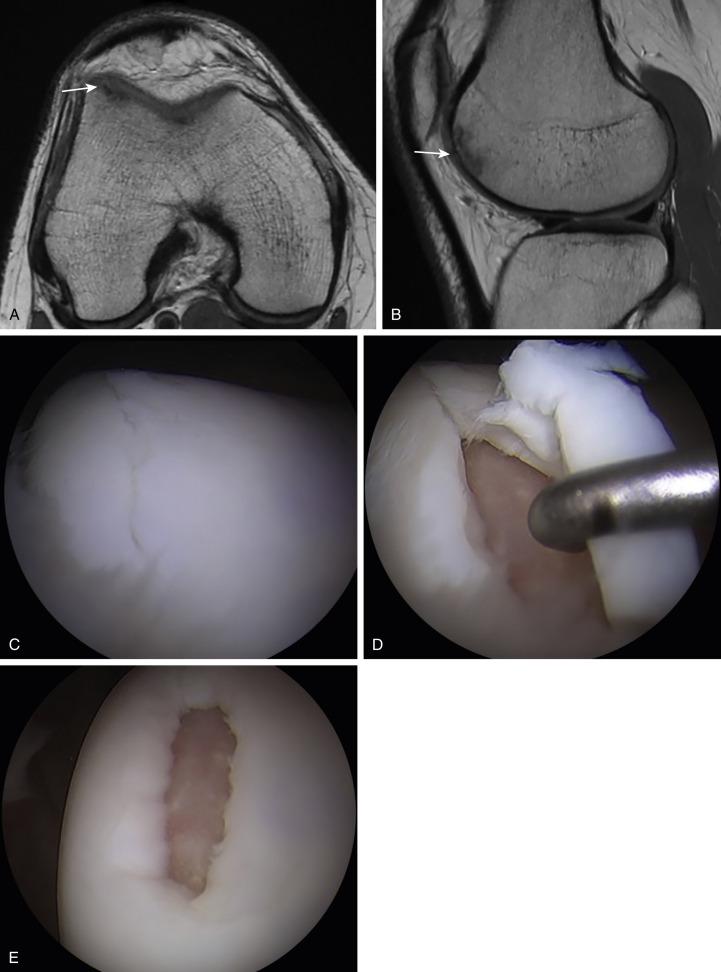Physical Address
304 North Cardinal St.
Dorchester Center, MA 02124
Chondral injuries are becoming an increasingly recognized cause of pain and disability in the knee. , When patients with focal symptomatic chondral defects fail nonoperative management, surgical intervention is offered. There are many options for surgical treatment of symptomatic cartilage defects, and these options can be separated into palliative, reparative, restorative, and reconstructive procedures. Palliative procedures include lesion debridement and loose body removal. Reparative procedures include microfracture and drilling where the purpose is to fill the articular defect with fibrocartilaginous tissue. Restorative procedures include autologous chondrocyte implantation (ACI) and matrix-associated autologous chondrocyte implantation (MACI), which allow creation of a hyaline-like cartilage layer to fill the defect. Finally, reconstructive procedures involve osteochondral grafting, either with autograft or allograft, where fully mature hyaline cartilage and bone are transplanted into the defect.
Results following surgical treatment of cartilage defects have a wide range of success, with several patient factors including age, sex, lesion size, lesion location, and others having an effect on surgical outcome. Complications following cartilage surgery can be separated into preoperative, intraoperative, and postoperative. This chapter will discuss the various causes of these complications and provide insight into ways to avoid and mitigate these problems before, during, and after cartilage surgery.
Reaching an accurate diagnosis and properly indicating patients for surgery is one of the most difficult aspects of treating patients with cartilage issues. It can sometimes be very difficult to determine if a cartilage defect is the sole cause of a patient’s complaints because asymptomatic cartilage defects are extremely common. , Aroen et al. performed a prospective study where the authors evaluated 993 consecutive patients who underwent knee arthroscopy for a variety of reasons and reported the arthroscopic findings as it related to cartilage defects. The authors found 66% of knees had articular cartilage defects, with 20% of knees having isolated articular cartilage defects without degenerative lesions, 11% having full-thickness cartilage defects, and 6% having full-thickness cartilage defects of more than 2 cm. It was unclear exactly what proportion of the patients’ symptoms, if any, were coming from these cartilage defects. A similar study by Curl et al. reported comparable results, with 63% of 31,516 knee arthroscopies demonstrating cartilage defects. Hence, simply because a cartilage defect is seen on magnetic resonance imaging (MRI) does not mean it is the sole cause of the patient’s complaints, or even a contributing factor. For this reason, it is imperative the surgeon take an accurate history and tease out the most likely cause of the patient’s symptoms.
Patients with symptomatic cartilage defects typically present with localized pain in the area of the knee where the defect is, with or without swelling. Instability is not a symptom commonly caused by a cartilage defect, and patients who present with instability as their main complaint should be evaluated for a different cause of pain. Furthermore, patients with diffuse chondral wear are rarely symptomatic from one particular area of cartilage loss and should not be indicated for a cartilage procedure, as the results will likely be disappointing.
Accurately imaging a focal chondral defect in the knee can be challenging, and underestimating the size of a lesion is a preoperative factor that can lead to intraoperative and postoperative complications. All patients who present with what appears to be a symptomatic cartilage defect should have a complete set of x-rays, including weight bearing anteroposterior, flexed posteroanterior, lateral, and Merchant views of the knee. Although these plain films may show osteochondral defects, it is very difficult to accurately measure the true size of the defect from these x-rays. One of the most important preoperative pieces of information is the defect size because it is one of the crucial factors that guide treatment. Many studies have shown higher failure rates for reparative procedures in larger defects (>3.0–4.5 cm 2 ) when compared with restorative and reconstructive procedures. , , As such, it is important to accurately measure the defect size preoperatively to formulate a surgical game plan to optimize results. Advanced imaging modalities such as MRI are critical aspects of the preoperative workup.
Unfortunately, although MRI offers the most accurate insight into the cartilage defect as well as to the rest of the soft tissue structures of the knee, studies have found preoperative MRI underestimates lesion size at the time of arthroscopy. , Gomoll et al. evaluated 38 patients with symptomatic full-thickness cartilage defects who underwent knee arthroscopy and arthrotomy with ACI (patients with osteochondral autograft and allograft were excluded) within 12 months of obtaining their MRI, and compared defect size between the preoperative MRI and following debridement at the time of surgery. The authors found that MRI significantly underestimated the average total defect size of the cartilage lesions when compared with measurements taken intraoperatively (3.6 cm 2 vs. 6.0 cm 2 respectively), and that 85% of the time, the defect size was larger intraoperatively than on the MRI. Therefore although obtaining an MRI is critical to evaluate the cartilage status of the rest of the knee, involvement of subchondral bone, and so on, surgeons must understand that the defect is often larger at the time of surgery and be prepared to switch procedures at the time of surgery based on intraoperative findings ( Fig. 20.1 A-E ).

Become a Clinical Tree membership for Full access and enjoy Unlimited articles
If you are a member. Log in here